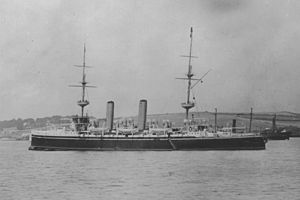HMS Juno (1895)
 Juno circa. 1901
| |
| History | |
|---|---|
| Name | HMS Juno |
| Namesake | Juno |
| Builder | Naval Construction & Armaments Co., Barrow-in-Furness |
| Laid down | 22 June 1894 |
| Launched | 16 November 1895 |
| Completed | 16 June 1897 |
| Fate | Sold for scrap, 24 September 1920 |
| General characteristics | |
| Class and type | Eclipse-class protected cruiser |
| Displacement | 5,600 long tons (5,690 t) |
| Length | 350 ft (106.7 m) |
| Beam | 53 ft 6 in (16.3 m) |
| Draught | 20 ft 6 in (6.25 m) |
| Installed power |
|
| Propulsion | 2 shafts, 2 Inverted triple-expansion steam engines |
| Speed | 18.5 knots (34.3 km/h; 21.3 mph) |
| Complement | 450 |
| Armament |
|
| Armour |
|
HMS Juno was an Eclipse-class protected cruiser built for the Royal Navy in the mid-1890s.
Juno was assigned to the 11th Cruiser Squadron operating from Ireland.
In 1901, she was one of two escort ships for HMS Ophir, which carried the Duke and Duchess of Cornwall and York (later King George V and Queen Mary) during their tour of the British Empire.[1]
The following year she served in the cruiser squadron under the command of Captain . In May 1902 she was taken into Portsmouth for a refit,[2] and the following month Captain David Beatty was appointed in command.[3] She took part in the fleet review held at Spithead on 16 August 1902 for the coronation of King Edward VII,[4] and visited the Aegean Sea for combined manoeuvres with other ships of the Channel squadron and Mediterranean Fleet the following month.[5] After returning to Portsmouth in October,[6] she carried the Lord-Lieutenant of Ireland and Lady Dudley on a visit to Waterford on 29 October.[7] She was posted to the Mediterranean Fleet later that year, but Beatty paid her off not long after.

In 1915 she was sent to the Persian Gulf and took part in an engagement at Bushire in July – August 1915 against Tangistani raids under Rais Ali Delvari. Juno was returning to Queenstown, Ireland. Having received warning of submarine activity off Queenstown, the cruiser took evasive action and eventually returned to port. This warning was not extended to RMS Lusitania, which was sunk by a U Boat on Friday, 7 May 1915.
In November 1916 Juno carried Abdulaziz bin Abdul Rahman Al Saud to Bushire to visit Sir Percy Cox, the British Political Resident in the Persian Gulf.[8]
Juno was sold for scrap in 1920.
Footnotes[]
- ^ Leckie 1914, p. 386
- ^ "Naval & Military intelligence". The Times. No. 36756. London. 1 May 1902. p. 6.
- ^ "Naval & Military intelligence". The Times. No. 36774. London. 22 May 1902. p. 8.
- ^ "The Coronation - Naval Review". The Times. No. 36845. London. 13 August 1902. p. 4.
- ^ "Naval & Military intelligence". The Times. No. 36880. London. 23 September 1902. p. 8.
- ^ "Naval & Military intelligence". The Times. No. 36902. London. 18 October 1902. p. 9.
- ^ "Ireland". The Times. No. 36912. London. 30 October 1902. p. 10.
- ^ "HMS Juno, 2nd class cruiser - British warships of World War 1". www.naval-history.net. Retrieved 8 January 2022.
References[]
- Chesneau, Roger; Kolesnik, Eugene M., eds. (1979). Conway's All the World's Fighting Ships 1860–1905. Greenwich, UK: Conway Maritime Press. ISBN 0-8317-0302-4.
- Gardiner, Robert; Gray, Randal, eds. (1985). Conway's All the World's Fighting Ships: 1906–1921. Annapolis, Maryland: Naval Institute Press. ISBN 0-85177-245-5.
- Leckie, Halton Sterling (1914). The King's Ships: Vol. III. London: Horace Muirhead.
- McBride, Keith (2012). "The Cruiser Family Talbot". In John Jordan (ed.). Warship 2012. London: Conway. pp. 136–41. ISBN 978-1-84486-156-9.
External links[]
 Media related to HMS Juno (ship, 1895) at Wikimedia Commons
Media related to HMS Juno (ship, 1895) at Wikimedia Commons
- Ships built in Barrow-in-Furness
- Eclipse-class cruisers
- 1895 ships
- United Kingdom naval ship stubs